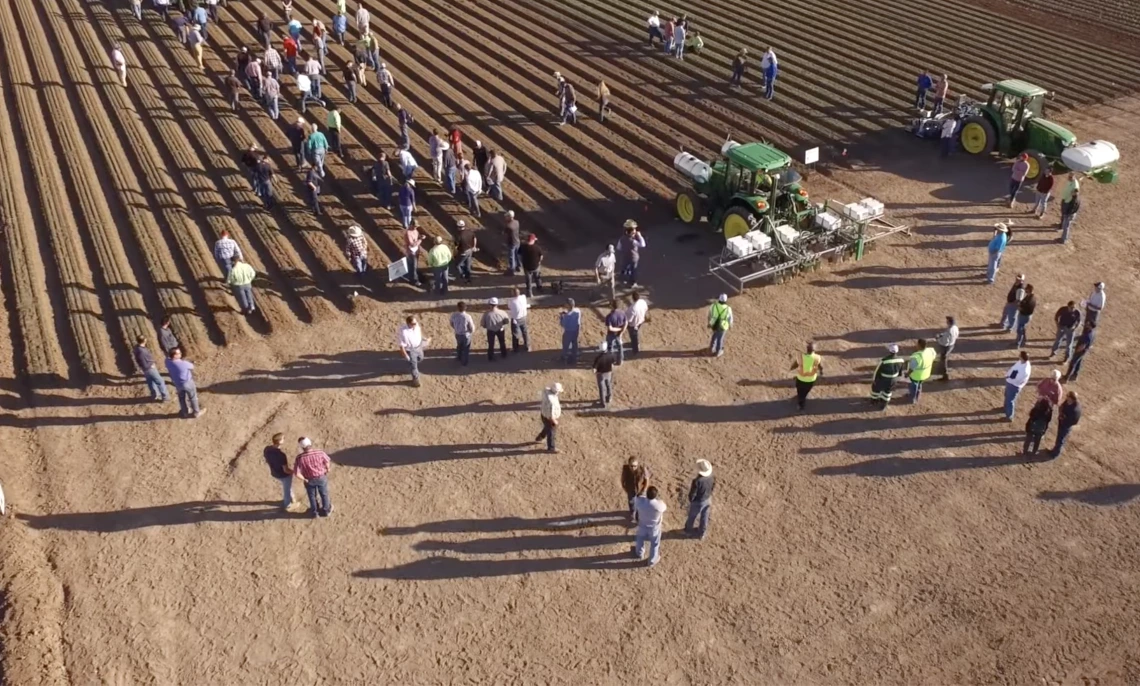Lighting up the field for precision agriculture
The Cyber Experiment Station - in collaboration with UITS, the Yuma Center of Excellence for Desert Agriculture, and Sun Corridor Network - launched 10GB internet service in Yuma to provide corner-to-corner in-field wireless internet.

High-speed internet access is crucial for education, economic development and agriculture, particularly in a region that produces over 90% of North America’s winter vegetables. Yuma, Arizona, has until recently faced connectivity challenges, but now thanks to a subaward from the National Science Foundation's Campus Cyberinfrastructure program, Yuma growers have access to 10G fiber broadband. The project also positions our Yuma operations as a hub for precision agriculture’s big data throughput in the space of arid-environment sustainability.
“Yuma is the agriculture powerhouse for leafy greens for the nation, but we were not able to convince these big internet service providers to come out, so we were hampered by the limitations of the network that we had,” said Matt Rahr, director of the Cyber Experiment Station. “Enter the Sun Corridor Network, which looked at this from a research and education angle, and here we are bringing true fiber technology to the farm.”
The Campus Cyberinfrastructure (CC*) invests in projects that help overcome disparities in connectivity associated with geographical location. Partnered with the Sun Corridor Network, the initiative helped deliver high speed external connectivity, wireless networks, and Internet of Things (IoT) systems to the Yuma Agricultural Center within the Arizona Experiment Station, the University of Arizona Yuma Academic Center, Arizona Western College and the Yuma Union High School District.
The need for speed
The use of technology in farming and agribusiness is rapidly growing, helping farmers discover ways to improve yields and align production with changing environmental conditions. By collecting and monitoring field data, producers can plan and assess crop growth.
IoT devices in farming have revolutionized agriculture by enabling real-time monitoring and precision management of crops, livestock and equipment. From soil moisture sensors for irrigation, to drones that monitor crop health from above, to laser weeders that use artificial intelligence (AI) to target weeds, these connected devices provide farmers with valuable data to improve efficiency.
Combined with Yuma’s innovative arid-land crop production practices, IoT devices can be a gamechanger for sustainability research. With its year-round growing season, Yuma plays a key role in agriculture globally. However, until recently, despite its economic potential, the region had often been overlooked by traditional internet service providers.
A transformative grant
Recognizing the need for robust internet infrastructure, the team set out to bridge the connectivity gap in Yuma. They implemented a three-tier service system including Wi-Fi, a wireless broadband service for cellular data (CBRS), and a low-power, wide-area networking service (LoRaWAN) that allows battery and solar-operated devices to connect to the internet. This all-encompassing approach ensures that Yuma receives high-speed internet from corner to corner.
“Now there is a location to come and test, train for, and showcase agricultural technology, so when the technology is ready to go to the farmer it is ready to be implemented,” said Tanya Hodges, executive director of the Yuma Center of Excellence for Desert Agriculture. “The big goal is for all of Yuma to integrate smart-farm capabilities, and this is one piece of that puzzle.”
In the future, the team hopes that improved connectivity will extend beyond research farming to everyday agricultural operations. As high-speed internet becomes more widespread, the use of IoT technologies in farming practices can grow, enabling more precise, tech-driven agricultural methods.
“We want to make sure that the solutions that we're bringing and demonstrating are just around the corner from what you'll be able to do on your own,” said Rahr. “I think we’ve seen some really sci-fi stuff with all this use of AI, but some of this technology is already here and it just needed more network capacity to unlock its potential.”

